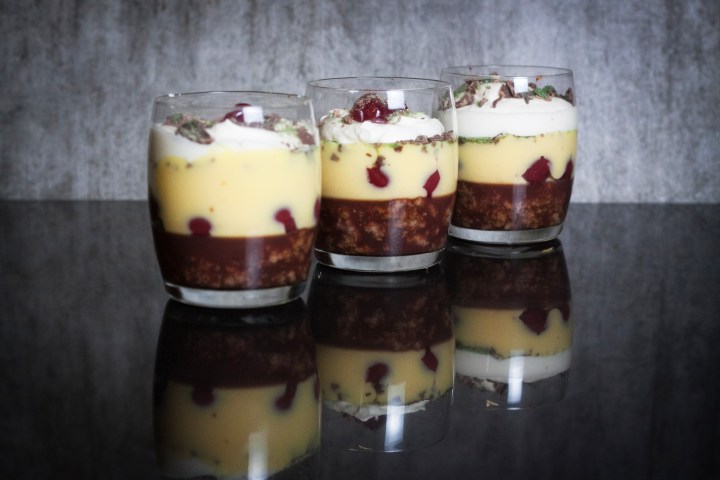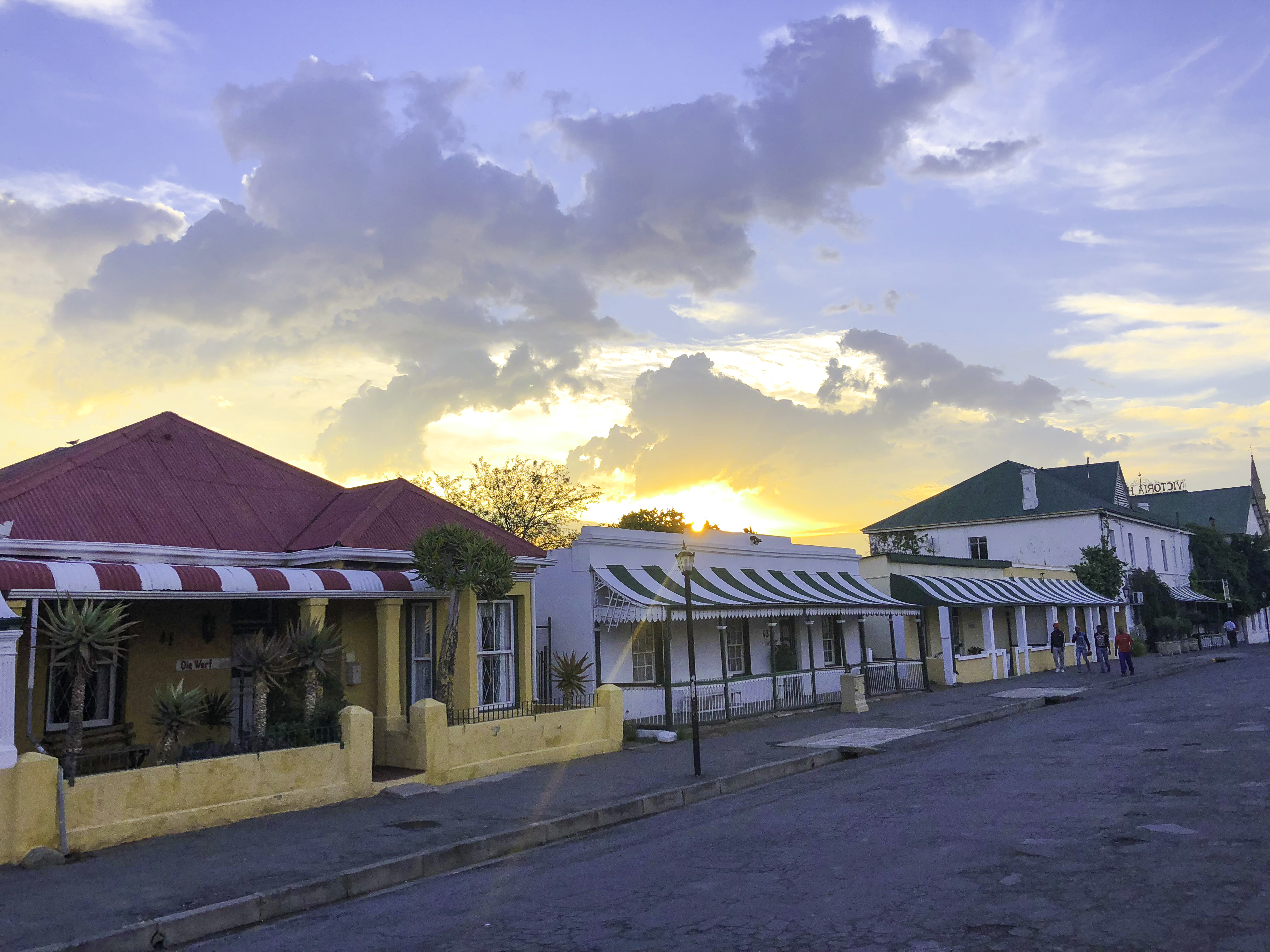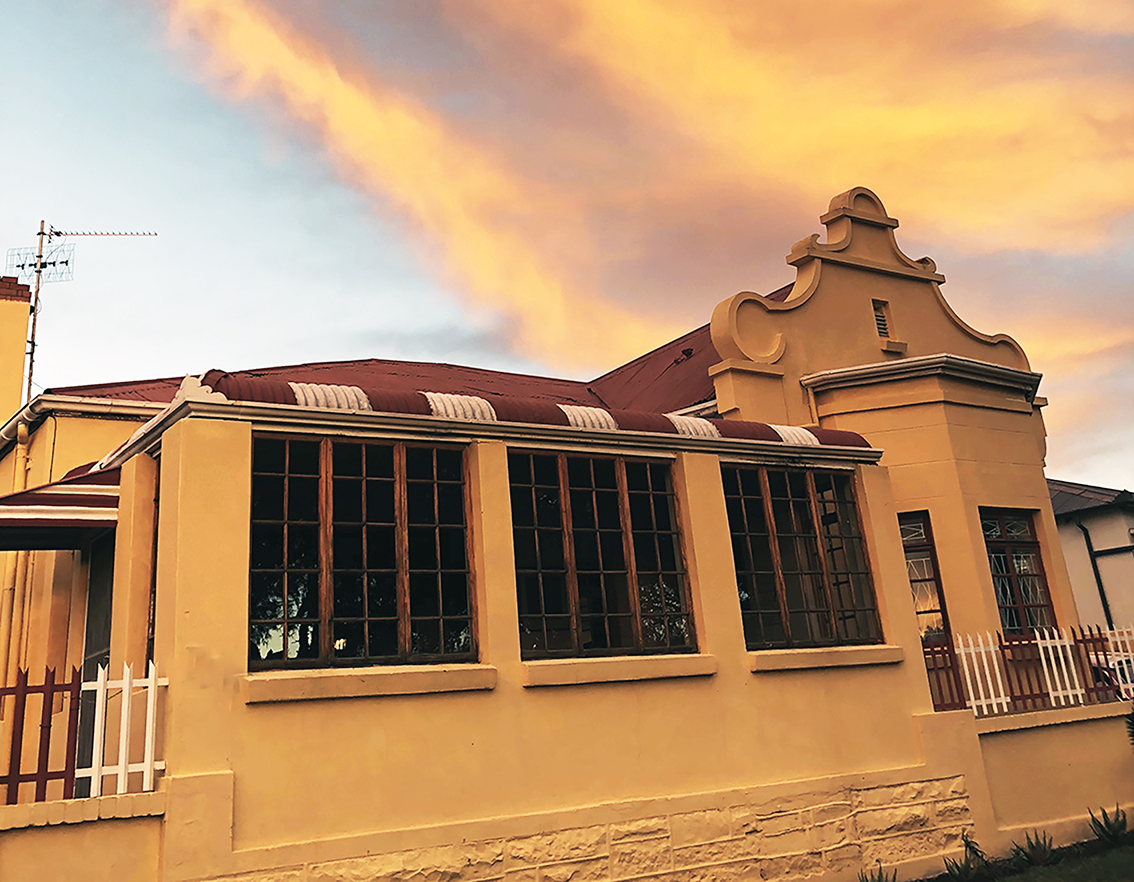GASTROTURF
Panic @ the Pop-Up: Turkey & Trifle beneath a Karoo afdakkie

Having a pop-up restaurant, even for one night, is Hard Work. Your feet, legs, hips – and joints you didn’t know you had – will ache by the end of the night, and once the last guest has gone home you’ll need to crack open the whiskey and chill till 3am to recover.
Stoeps. Afdakke. Other than a windmill, there’s no architectural feature of the Karoo more familiar and soul-affirming than the broad, airy porches that grace the houses in every town, and the mini roofs that shade them. Some are wavy, others curved, yet others flat; some are trimmed with broekielace, others not. They’re among the treasures of the vastness of the South African interior, a stamp of individual character setting every house apart from the next. Some stoeps have views of dreamy Karoo vistas – lonely windmills and random sheep, a conical koppie seemingly built by stray Pharoahs. Others have a view of the afdak across the road. Yours is rusty-red, theirs shimmering teal.
We paint them in colours to suit our own palette, or we follow tradition. In some towns they’re the distinct Karoo green that is most thoroughly represented in Graaff-Reinet; in others, that distinctive rusty-red-brown. In Sandra Antrobus’s lovely Tuishuise in Cradock’s Market Street the roofs are painted green or red, but their afdakkies boast jaunty stripes. Our own afdak borrows that style, in broad red-and-white stripes.

Photo: Tony Jackman
There are stoeps in New York City too, we discovered when we visited in 2013, although they spell it “stoop”, from the Dutch who settled there in 1624 and built houses – from the indigenous dark-hued sandstone – which came to be known as brownstones, after that hue. Their stoops’ shapes are different too – rather than being long porches, they’re broad steps to the landing at the front door of the large terraced brownstones that characterise the city’s residential streets, both in Manhattan and Brooklyn. You don’t really see them when admiring a typical NYC skyline view from afar, but they’re down there, around every corner. Just as our own stoeps are in the Karoo.

Photo by Jahsie Ault on Unsplash
So the Karoo and New York City have an unlikely commonality: the stoop that is so characteristic of Manhattan and Brooklyn’s residential streets came to them via the Dutch West India Company when the Dutch established their New Netherland colony in what is now New York in, 1624, and just more than three decades later the Dutch East India Company brought Dutch culture to what would become the Cape Colony. The houses of the Karoo, now so typified by their stoeps and afdakkies, were only built in the second half of the 19th century – a great many of them date to the 1860s – but the culture, and with it words like “stoep”, has the same colonial roots as the “stoop”.
Manhattan is the very opposite of the Karoo – the latter is as horizontal as the former is vertical – so we found it strange that our Karoo souls somehow felt comfortable when dwarfed by the towers soaring above us. My eye for architectural beauty (which aligns with my adoration of old cars) was richly rewarded by every brownstone we passed, just as I become transfixed by Karoo houses and their afdakkie-topped stoeps.
Our Karoo stoep was long ago incorporated into the house, not by us but by some or other distant owner having decided to forsake the stoep and gain a massive front room, once it and the old front room became one. Which is where we have our occasional pop-up restaurants, such as the one we had last Saturday. Its size, as well as its wall of windows overlooking the street, makes it an ideal space for this.
You can gauge the size of the old stoep thanks to the giant flagstones that remain, which, when we bought the house after leaving Cape Town nearly five years ago, we had clear-varnished – three coats – which had the delightful effect of making the slabs look marble-like.

Photo: Tony Jackman
Along the way we’ve collected tables – which happens when on occasion you go mad and open a restaurant in the Karoo only to close it again once you’ve come to your senses or somebody offers you a proper job (thank you, Daily Maverick) – and not quite enough chairs. Last week we had to nip out to buy four more from our wonderful local second-hand-everything store, More4Less (which locals like to call Less4More, although they’re great at being bargained down – don’t tell them I told you that), when we realised there were four fewer chairs than the number of people coming to dinner. More4Less is massive; a warehouse-sized store selling everything you can think of. Antique furniture, crockery, “white goods”, as the British call kitchen appliances, curtains, lawnmowers, plant pots, bedroom furnishings, books, tools, office furniture, paintings and prints, glassware, milk urns, fireplaces, tea sets, re-upholstered lounge suites. There are even things hanging from the ceiling. It’s mad in there. You must go if you visit.
Luckily, we had the common sense to keep our stock of cutlery, plates and the like when last we had an actual restaurant, a little bistro in Cradock, four years ago. Just in case. So when we want to turn the front room into a restaurant for a night, we have the goods. We just need to add food, and a whole lot of elbow grease.
And don’t kid yourself. Having a pop-up restaurant, even for one night, is Hard Work. Your feet, legs and joints you didn’t know you had will ache by the end of the night, and you will need to crack open the whiskey and chill till 3am so that you can recover. As my sous chef mate and I did on Saturday night.
It may or may not work. You won’t know until you’ve chosen your theme, planned your menu, and got your photographer mate Louis to design a flyer and market the event. This one worked – we had 23 of the 24 available spaces filled. The previous one, which was to have been a very meaty Karoo dinner on the Saturday night of the annual Karoo Food festival in t0wn, did not. On the Wednesday before it was to happen, we decided to cancel. You can’t afford to buy all the meat, vegetables and everything else “just in case” people decide to book at the last minute.
You find, when the day comes, that someone or other will say, “Oh hi, ja, we’re thinking of coming to your pop-up tonight, do you have space?” That’s like cooking steak, eggs and chips for the empty table in the corner “just in case” somebody walks in wanting to order that. It can’t work.
This time – for the Christmas in July dinner we had on Saturday night – even 10 days before the event, we were unsure of whether it would be worthwhile going ahead. At that stage only two people had booked. Then we did one more round of marketing and everyone who had thought of booking, booked. And we were away.
At some point between deciding it’s worth going ahead, and the night, you’ll have a panic attack. What the hell have you got yourself into? What possessed you? Is it too late to call the whole thing off? Of course, it is too late if they’ve booked. But you’ll have that moment.
The worst moment is the one you might expect to be the most exciting – when the first people arrive. It means there’s no going back, and that you’d better get on with it. Fast. It’s your point of no return. You’re either going to pull it off, with aplomb you hope, or you’re going to regret having done it. And you won’t know until the last people have left.
Car headlights pull up in front. $Ҹ¶ṫ, it’s only seven o’clock. The invitation is 7.30 for 8. You dart back into the kitchen and check the sauce, the courgettes, the glaze, the potatoes, the tomato-coconut soup. What still has to be cooked, are the plates warm, is the beef tender, is the turkey dried out or still moist? Earlier in the day you’ve decided what to cook when, what to have ready and keeping warm, and what to cook à la minute.
Somewhere along the way there’ll be something you’ve forgotten to buy, or run out of, and have to nip to a shop to get it. There were several such moments last Saturday. We forgot to buy mustard, we ran out of onions (twice), we hadn’t bought leeks and celery for the gammon stock. We bought three packs of coriander leaves but one of them turned out to be flatleaf parsley (come on, they do look similar when you’re not focusing properly because you’re tripping over your shoelaces to get back home). Mad dashes to the shops and back by one of us while the other guy in the kitchen plays catchup.
There may be injuries. My kitchen right hand had bought a new chef’s knife, a fine, heavy one, super-sharp. I cut myself three times. After having burnt my left hand. Twice. The third cut was in the same place as the second burn. That was just cruel. But you can’t stop. You staunch, slap a plaster on, and carry on.
As it happens, we pulled it off. There was the spiced tomato soup, finished with coconut cream, a risk-taker if ever there was one, but it truly was delicious. I tasted it next day, and it was even better chilled (I’ll publish the recipe alongside). We’d finished it with a coriander leaf drizzle, so we had the red and green colours of Christmas. There was turkey and gammon and a whole joint of sirloin; roast potatoes, stir-fried garlicky courgettes, red cabbage with red onion and raisins; and finally, individual trifles laced with brandy, topped with Frangelico-infused cream, garnished with glacé cherries and crumbled peppermint crisp. (Crumbling peppermint crisp is great fun: You place them in their foil, side on, and bash the living daylights out of them with a heavy, blunt instrument. I used an iron hammer. All the day’s frustrations were gone in minutes. When you open the foil, the contents have become bits of chocolate and beautiful, shiny green shards.)
There was focus and stress and verge-of panic in the kitchen during service, hands everywhere to get the plates and dishes out efficiently, eyes running over plates to be sure nothing’s been left off, barked “don’t forget the courgettes” and “wipe the edge of that plate” – as 20-odd people are all served at the same time.
But most of all, once the last trifle had gone out, relief that it was done. And a determination that the next pop-up restaurant beneath the striped afdakkie in the big front room would be a curry night, in late September. Served buffet-style, to avoid the last-minute plating panic. And then there was whiskey. Lots of whiskey. DM
There are more tales of the Karoo in Tony Jackman’s foodSTUFF (Human & Rousseau), a cookbook-cum-memoir with essays about life and food, illustrated by 60 recipes, which was nominated for the Gourmand World Cookbook Awards (2018) in the category for best food writing. Book enquiries: [email protected]





 Become an Insider
Become an Insider